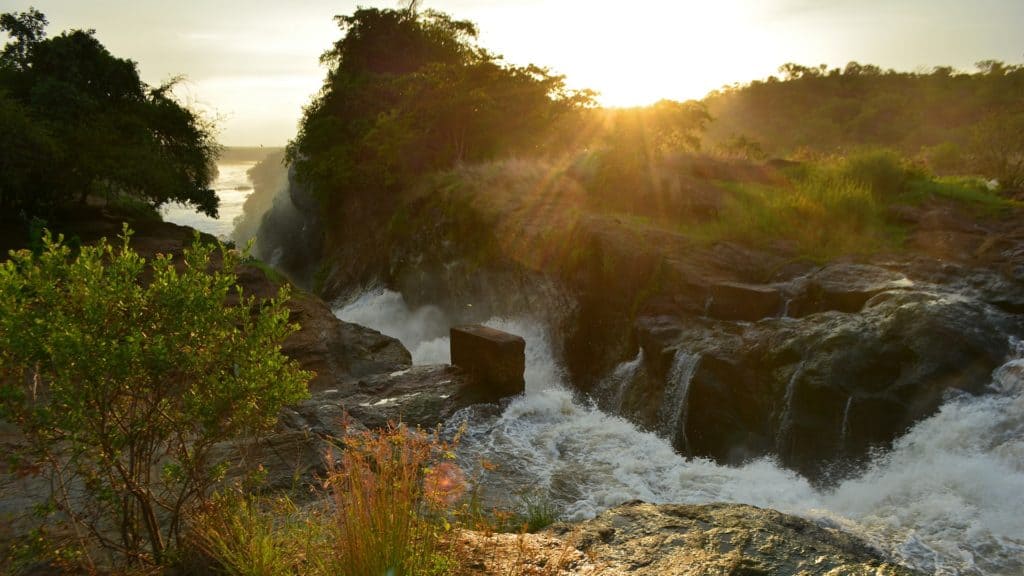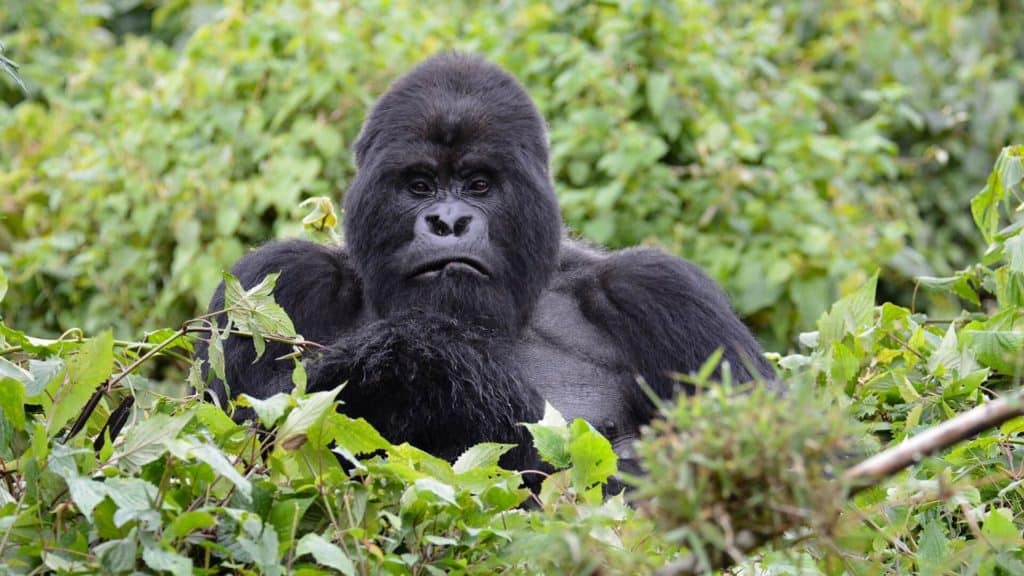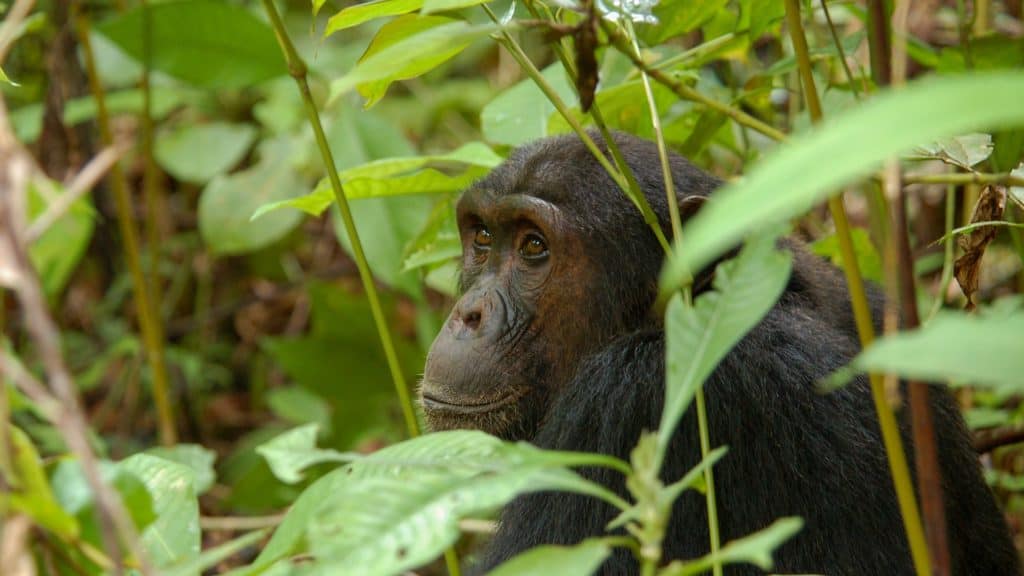Uganda
The Pearl of Africa:
An Eden for Primates and Birdlife
“For magnificence, for variety of form and color, for profusion of brilliant life—bird, insect, reptile, beast—for vast scale—Uganda is truly the Pearl of Africa.” – Winston Churchill, My African Journey
Nestled in the western corridor of the Great Rift Valley between Africa’s highest mountain range and the world’s second largest freshwater lake sits Uganda—a country of vast ecological diversity, warm and charming local people, and breathtaking beauty.
While gorilla trekking is the driving force of tourism in Uganda, the country is full of gems. Uganda is one of the top birding destinations in Africa, it is believed to have the highest diversity of primate species, it is the major source for the world’s longest river, the vast savannahs are a haven for megafauna, and the rolling hillsides with crater lakes and towering volcanic mountains offer unbeatable hiking opportunities.
Uganda primate trekking (gorillas and chimpanzees specifically) can easily be combined with a classic East Africa safari through convenient flight connections from the Masai Mara or Serengeti to Bwindi Impenetrable Forest and Kibale Forest. For those with the time and interest, a deeper exploration of Uganda rewards
with wildlife, landscapes, and cultural experiences. The destination is well suited to nature lovers and adventurers who wish to explore out of the vehicle.
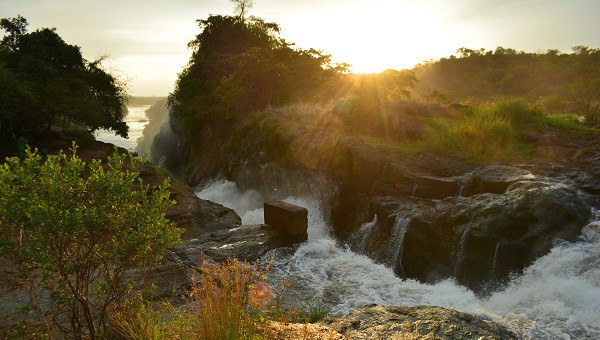
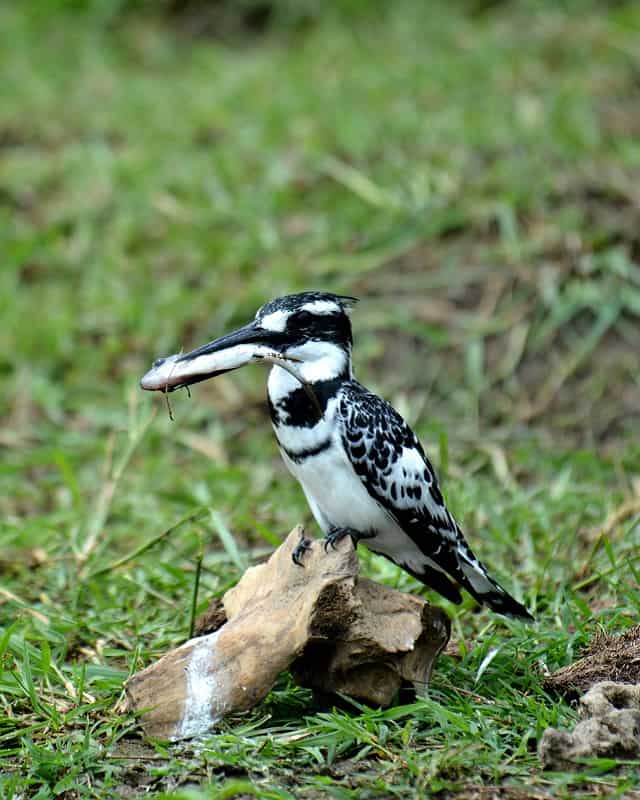
Uganda Sample Safaris
Ultimate Uganda
This safari has been custom designed to provide an in-depth adventure in Uganda featuring some of the most intimate and immersive experiences on the continent – primate trekking.
Uganda 4-Day Gorilla Trekking
This extension features gorilla trekking in Uganda, where you’ll experience up-close viewing of the mountain gorillas in Bwindi.
Top Uganda Safari Locations
Uganda Safari Regions

Kidepo Valley National Park
Overview
Nestled in the remote corner of Uganda on the border with Kenya and Sudan, sits Uganda’s second largest national park waiting to reward the intrepid wildlife enthusiast with one of Africa’s last great wilderness areas. The vast savanna grassland of Kidepo Valley National Park is framed by the towering Mount Morungole and comprised of the Narus Valley to the southwest and Kidepo Valley to the north.
In addition to the wildlife experiences, it is possible to visit local indigenous communities including the pastoralist Karamojong community as well as the Ik people who live in the Morungole Mountain Range with numbers just in the thousands. The Ik have been studied by linguists whose research suggests that their ancestry spans as far as southern Egypt.
Location
Kidepo Valley National Park sits on the northern border of Uganda and spreads north into Sudan as Kidepo Game Reserve. To the east is Kenya’s remote desert and Lake Turkana. There is an airstrip at the national park for convenient connections between safari regions. Road-based safaris typically use Ziwa Rhino Sanctuary and Murchison Falls National Park as stops en-route due to the 10-hour transfer distance from Entebbe.
Wildlife
Carved by the perennial Narus and Kidepo Rivers, the valleys host a variety of wildlife with good concentration of species during the dryer months. Wildlife includes giraffe, zebra, buffalo, lion, leopard, cheetah, eland, roan, striped hyena, spotted hyena, and many more species. Of the 75 mammals, 28 are endemic, and the park hosts 470 bird species.
Best Times to Go
During the dry season months, the only permanent water sources in the park are the wetlands and ponds near Apoka in the Narus Valley. This creates great concentration of wildlife around the only lodge located inside the national park. While weather patterns continue to become more unpredictable, the typical short storms occur mid-March to mid-May and again mid-October to mid-November. Kidepo is semi-arid, so typically the ground dries quickly after storms.

Entebbe
Overview
While Kibale is the capital of Uganda, Entebbe is the gateway. This quaint city on the edge of Lake Victoria, the world’s second largest freshwater lake, is a convenient starting and ending point for an exploration of the country. Those who wish to enjoy some extra time in the city before or after their wildlife experiences can be rewarded by wonderful outings in the city, including the Entebbe Botanical Gardens, Uganda Wildlife and Education Centre, and excursions to the Mabamba Wetlands for good chances to view the rare shoebill stork. There are craft markets and cultural outings that can easily fill up a day or two.
Location
Entebbe is on the southeastern border of the country on the shores of Lake Victoria. There are nonstop flight options from Europe and several African countries, which even include direct flights from the Masai Mara National Reserve in Kenya.
Wildlife
Birding opportunities from Entebbe are quite good with quaint bed and breakfasts that attract beautiful song birds and colorful sunbirds to their lush gardens as well as the nearby Mabamba Wetlands for the chance to spot the shoebill stork. Behind-the-scenes tours of the Uganda Wildlife and Education Centre offers the chance to view wild animals, such as chimpanzees, with no direct contact that would otherwise require additional vaccinations.
Excursions to Ngamba Island Chimpanzee Sanctuary are on offer. While the half-day outing to the 100-acre island includes a brief viewing of the chimps, the excursion is predominantly a chance to support the cause and learn about conservation. There are more comprehensive viewing opportunities available for those who overnight on the island, however, accommodations are very basic and a visit requires extra vaccinations.
Best Times to Go
Entebbe can be visited year-round.

Bwindi Impenetrable National Park
Overview
Bwindi Impenetrable Forest is one of the largest remaining ecosystems where the lowland forest belt still connects to the montane forests. It is a remnant of an ancient forest swath that spanned much of Western Uganda, Burundi, Rwanda, and the DRC. It is a critical wilderness area that protects some of Uganda’s oldest forests and richest areas of biodiversity. The park is home to nearly half of the world’s endangered mountain gorillas, which through conservation efforts persist despite the pressures from surrounding population density and agricultural expansion. The survival of the mountain gorilla relies on tourism proceeds that directly benefit surrounding communities.
There are four different regions of Bwindi: Buhoma, Ruhija, Rushaga, and Nkuringo. Within the regions, there are 14 habituated gorilla groups. Travelers purchase a permit within one of the four zones and then are assigned to a gorilla family on the day of the trek by Uganda Wildlife Authority.
In addition to gorilla trekking, visitors to Bwindi can enjoy a variety of forest walks and cultural experiences. A Batwa community visit provides travelers with the opportunity to learn about the heritage of the Batwa people who no longer live their traditional lives inside the national park after being relocated outside of the park boundary. It is important to request a Batwa community visit in advance as the best experiences require a free day in Bwindi. It is also possible to visit Dr. Scott’s Community Health Clinic, craft shopping, and the community-run Bwindi Bar.
Location
Bwindi Impenetrable National Park is on the edge of the Great Rift Valley in the southwestern border of Uganda in a continuous mountain ecosystem between Rwanda and the DRC. Road transfers across the border from Rwanda, Queen Elizabeth National Park, or Kibale Forest are possible as well as bush flights to reduce the transfer time between activities or for those on a shorter travel schedule.
Wildlife
The forests of Bwindi are some of the country’s oldest, spanning approximately 79,000 acres (32,000 hectares) and a 5,000-ft (1500-meter) variation in altitude. Coupled with the park’s location as a convergence between ecological zones of the Albertine Rift, Congo Basin, and Eastern Africa, the result is a staggering level of biodiversity with over 200 tree species (10 endemics), over 100 species of ferns, and 84% of the country’s 240 butterfly species. Among the 120 mammals are gorilla, chimpanzee, l’Hoest’s monkey, African elephant, and bushbuck. Over 347 bird species are found here, including 23 of the 36 Albertine Rift endemics.
Best Times to Go
The driest months offer the best visibility and trail conditions, but it is possible to trek to gorillas year-round. Rain is possible any time of year with the wettest months usually being April to June.

Kibale Forest National Park
Overview
Kibale Forest houses 13 different primate species including a large group of habituated chimpanzees. There are 9 diurnal species, which can be seen on a forest trek: vervet monkeys, red-tailed monkeys, l’Hoest’s monkeys, blue monkeys, grey-cheeked mangabeys, red colobus monkeys, black and white colobus monkeys, olive baboons, and chimpanzees.
Chimpanzee treks are offered as either morning, afternoon, or full-day outings. The surrounding area offers a variety of activities as well, including a nature walk through the Bigodi Wetland Sanctuary, hikes through rolling hillsides and crater lakes, visits to tea plantations, and cultural experiences.
Location
Kibale Forest National Park is located north of Queen Elizabeth National Park, east of the Rwenzori Mountain Range, and near the town of Fort Portal. It is a nearly equidistant 6-hour drive to reach Kibale from Entebbe, Murchison Falls National park, or Bwindi Impenetrable National Park. Many travelers enjoy stopping in Queen Elizabeth National Park en route between Bwindi and Kibale for further wildlife viewing. The closest airstrip is in Fort Portal, which is approximately 1 hour from the national park.
Wildlife
Chimpanzees are the main attraction here. There can be no other wildlife viewing experience that can connect with one’s soul more than spending time on foot with our closest wild relative.
The chimps can be loud, energetic, and dynamic making viewing extremely exciting with amazing observational opportunities, possibly revealing behaviors that are very familiar and shared with humans. Time with chimps may resonate in your soul forever after.
Beyond the chimps, there are seven other primate species, including both red colobus as well as black and white colobus monkeys. There are many bird species, but with the thick jungle they are often heard more than seen. One nice surprise is a stunning array of butterfly species.
Best Times to Go
Certain months like April and May are more likely to encounter rain, which may result in chimpanzees remaining in the tree canopies to seek shelter until the rain dissipates. The opportunity to see the chimpanzees while on the ground moving between fig trees is the most convenient opportunity to view them closely and provides the best photography opportunities as the dark animals are usually back-lit when photographing up into the trees.

Queen Elizabeth National Park
Overview
Originally named Kazinga National Park, Queen Elizabeth National Park was renamed two years after it was founded to honor a visit by Queen Elizabeth II in 1954. This beautiful park spans the massive Lake Edward and Lake George, connected by the Kazinga Channel. The grasslands of the Ishasha region lie south of the park, framed by the distant Rwenzori Mountains.
No visit to the park is complete without a launch trip on the Kazinga Channel for the opportunity to take in the scenery and observe a diversity of wildlife from the shoreline. The bird life is astounding, but mammal viewing can be surprisingly rewarding as well with the chance to see elephant, hippo, waterbuck, and Uganda kob regularly. In addition, it is possible to catch a glimpse of giant forest hog, leopard, and lion.
Unlike the relatively flat forest trails of Kibale, the chimpanzee trekking of Kyambura Gorge involves entering the 100-meter-deep gorge that sits between savannah grassland and papyrus swamps of the Kazinga Channel. The best time to trek is in the morning to avoid hot temperatures.
Travelers can visit nearby villages to learn about the fishing heritage, traditional salt mining, and coffee production in the area.
Many visitors to Queen Elizabeth National Park also enjoy easy guided walks into the Maramagambo Forest, which is one of the largest forests in Uganda and one of the few semi-deciduous, moist forests left. One of the most popular walks is to visit the Maramagambo bat caves, which house thousands of fruit bats. In addition, it is possible to visit the Katwe Crater Lakes. Formed from extinct volcanoes, the lakes provide wildlife viewing opportunities as well as beautiful scenery across the park and, on a clear day, into the neighboring Democratic Republic of Congo.
Location
Queen Elizabeth sits in the southwestern corner of Uganda between Kibale Forest National Park to the north and Bwindi Impenetrable National Park to the south. To the west lies the Rwenzori Mountain Range and the border with the Democratic Republic of Congo, which shares Lake Albert with Uganda.
Wildlife
The ecosystem diversity of the park provides habitat for 95 mammal species and over 600 bird species. The safari experience focuses primarily on boat-based exploration of the lake shores and channel as well as game drives throughout the park. It is also possible to trek in the Kyambura Gorge in search of the habituated chimpanzees.
The Kazinga Channel game drives offer chances to view warthog, bushbuck, waterbuck, elephant, hippo, and lion. Leopards are more habituated in this area, so are easier to spot here as well. It is also one of the rare places where giant forest hog can be seen in the daytime. From the Kayensi Plains, the savanna landscape is the most reliable place to see lions as well as the park’s largest variety of plains game.
Best Times to Go
The dry season offers the greatest concentration of mammal species near the permanent water sources, but bird life is excellent during the wetter months as the migratory species can be found passing through. In the Ishasha region in particular, the grass can get very tall towards the end of the rainy season and into June, making wildlife viewing more difficult.

Murchison Falls National Park
Overview
Transected by the Victoria Nile as it joins the White Nile at Lake Albert, Murchison Falls National Park is a wildlife haven as well as a park of breathtaking scenery. It is no wonder the park was one of the first to be established in Uganda. The impressive falls that give the park its name are formed as the Nile River rages through a rock gorge, called the Devil’s Cauldron, and plunges over the Albertine Rift nearly 150 feet (45 meters) below. The river continues through the park to Lake Albert, offering wonderful wildlife viewing opportunities by boat as well as a permanent water source that sustains an abundance of wildlife. The upper falls can be viewed by easy walking paths while the lower falls are viewed by boat trip.
Boat trips along the Nile River delta are the perfect way to enjoy bird watching and take in the scenery. Boat trips can be conducted as a full-day or half-day outing with a pick-up point in the park for a return by game drive and picnic lunch to round out the day. There are separate boat trips for visiting the lower Murchison Falls, which offer wildlife opportunities in addition to the breathtaking scenery.
For bird lovers who want the chance to increase their species count, the Budongo Forest on the southern side of the national park boasts 366 species including 60 West or Central African birds which can be found in less than five locations in East Africa. The forest is home to some of the most varied plant life in the whole of East Africa and houses Uganda’s largest chimpanzee population with over 800 individuals. While the chimpanzees have been habituated since the 90’s, the terrain is more challenging than in Kibale Forest. Fruiting trees are most reliably producing between May and August, making this the ideal time to view the chimps.
Location
Murchison Falls sits alongside Lake Albert in the northwestern region of Uganda. The road transfer from Entebbe to Murchison Falls is 6.5 hours through small towns that offer a glimpse into daily life in Uganda. There are also daily scheduled flights.
Wildlife
Murchison Falls is the only location in Uganda besides Kidepo Valley where giraffe can be found. It is home to 76 mammal species including lion, leopard, elephant, buffalo, Jackson’s hartebeest, bushbuck, Ugandan kob, waterbuck, warthog, baboon, colobus monkey, hippo, and more. The park is home to approximately 800 chimpanzees, however they have not been habituated. Crocodiles are often seen basking in the sunlight along the shores, and the bird life of Murchison Falls is a major attraction. With 451 bird species found in the park and good chances to encounter the rare shoebill stork, the bird life of Murchison Falls is also a major attraction.
Best Times to Go
Murchison Falls is a year-round destination, and the best seasons to visit depend on the wildlife interests of the individual. Drier months will attract wildlife to the river and fruiting trees improve chimpanzee trekking, while the wetter months are better for bird life.

Mgahinga Gorilla National Park
Overview
Mgahinga Gorilla National Park is the continuation of Rwanda’s Volcanoes National Park where Mount Sabyinyo and the Gahinga Volcano divide the countries. Reminiscent of the Rwandan forest landscape, Mgahinga offers gorilla trekking as well as golden monkey trekking. Currently, there is only one habituated gorilla family within the national park. There is also a transient family that came across the border from Rwanda that has not stayed long enough to be considered a permanent family in the national park.
The park holds cultural significance for the indigenous Batwa people. Traditionally forest-dwelling hunter-gatherers, they were forced to settle when the park was gazetted, and their cultural legacies are passed down between generations for cultural preservation rather than out of necessity. Visitors who make time to experience the Batwa culture will learn about their hunting techniques, daily life, and customs.
Location
Mgahinga Gorilla National Park is the southern boundary of Uganda where it connects with Rwanda and the Democratic Republic of Congo. It is accessed by scheduled flight to the nearby airstrip or can be combined with a road transfer from Rwanda or Bwindi Impenetrable National Park.
Wildlife
This is the only location in Uganda where the endangered golden monkeys can be seen and is home to one habituated gorilla family.
Best Times to Go
It is possible to trek to gorillas year-round, although the driest months offer the best visibility and trail conditions. Rain is possible any time of year, with the wettest months usually being April to June.

Rwenzori Mountains National Park
Overview
Coined by Claudius Ptolemy in AD 150 as the “Mountains of the Moon,” the Rwenzori Mountain Range has beguiled travelers since time immemorial. The jagged peaks are a staggering contrast from the equatorial forests and rolling foothills. Unlike the volcanic origin of most of the peaks in the Great Rift Valley, the Rwenzoris are a massive uplift along a fault line in the Western Rift, creating a unique ecosystem and important habitat for some of the world’s rarest flora.
Birding, hiking, and mountaineering are all activities available to the specialist and conducted by local communities. Hiking trails can be anywhere from one day to over a week. Options include summiting Mt. Stanley’s Margarita Peak, the third tallest mountain in East Africa, which is a technical ascent.
Location
The towering Rwenzori Mountain Range is the natural border between Uganda and the DRC on the western boundary of Uganda between Lake Albert and Lake Edward. Scheduled flights are available multiple times per day to the area.
Wildlife
The national park is home to 70 mammal species and 217 bird species, of which 19 are Albertine Rift endemics. The drastic elevation changes of the towering mountains create four distinct life zones of Afromontane forest, bamboo forests, Heather-Rapanea, and alpine with colorful mosses and giant lobelias. Wildlife is difficult to spot in the park, but primates, antelope, and even elephant call the park home. Even the chance to encounter some of the rarest endemics will require multiple days of trekking to reach higher elevations and remote habitats.
Best Times to Go
The drier months are from December to February, which will provide the most ideal trail conditions.

Semuliki National Park
Overview
Semuliki National Park sits on the border of Uganda on the remote western side of the Rwenzori Mountain Range in the Semliki Valley. The park protects the only true swath of lowland tropical forest in East Africa and is an important location for bird lovers to include if they hope to increase their species count. The park is one of the few forests of its kind to survive the last ice age, making it one of Africa’s most ancient and bio-diverse forest ecosystems. The park is more akin to Central Africa than East Africa due to its location and offers the chance to view 46 Guinea-Congo biome bird species found nowhere else in East Africa.
Location
The park is located on the western edge of Uganda just northwest of the Rwenzori Mountain Range, connecting the mountain range to Lake Albert with the Semliki River. The park is best accessed as part of a stay while exploring Kibale Forest. An airstrip is close by for convenient access, but many opt for road transfers.
Wildlife
The park has 441 recorded bird species (66% of Uganda’s forest species and 40% of Uganda’s overall species) and 53 mammals, including the pygmy antelope, fanged deer, and two flying squirrel species. Forest elephant are found as well as several primate species. Hippo and crocodile are prevalent along the Semliki River.
Best Times to Go
This is one of the wettest areas of Uganda, receiving up to 5 feet of rain during March to May and September to December. The dry season is June to September, which is when there is a greater concentration of mammals around water sources. January and February are hot and dry, but good for bird life.

Jinja
Overview
On the shores of Lake Victoria in southeastern Uganda, Jinja is the start of the mighty Nile River as it exits the lake and begins the long journey to the Mediterranean Sea. The town of Jinja is a beautiful area for relaxation, bird life, and the adrenaline-inducing activity of white water rafting on the Nile River.
Location
Jinja is a 2.5-hr road transfer along Lake Victoria from Entebbe.
Wildlife
This is a good area for bird life, but less so for general wildlife viewing as it is more of a city experience.
Best Times to Go
Jinja can be visited any time of year.

Lake Victoria
Overview
Larger than the country of Rwanda, Lake Victoria is the world’s second largest freshwater lake, the source of the Nile River, and the natural boundary between Kenya, Uganda, and Tanzania in the heart of the Great Rift Valley. It is a life source for thousands of flora and fauna and is the second-most diverse lake for fish species after Lake Malawi, but sadly a high percentage of the endemic species have gone extinct within the last 50 years caused by over fishing, the introduction of Nile perch, and eutrophication from fertilizer run-off.
Location
Lake Victoria is the eastern border of Uganda.
Wildlife
Mammals found in Lake Victoria include hippos, the African clawless otter, spotted-necked otter, marsh mongoose, sitatunga, reedbuck, defassa waterbuck, and more. The lake also has a large population of crocodiles among other reptiles and is the second most biodiverse lake in the world after Lake Malawi.
Best Times to Go
Lake Victoria can be visited any time of year.
